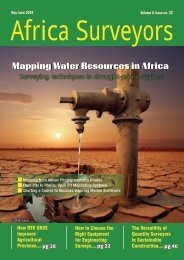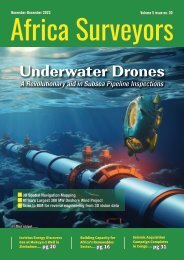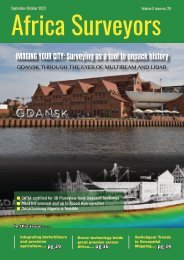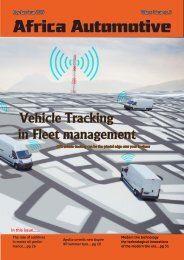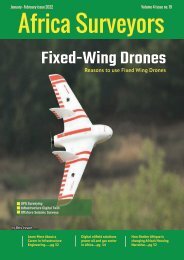Africa Surveyors May-June issue 2023 digital
Africa Surveyors is Africa’s premier source of Surveying, Mapping and Geospatial news and an envoy of surveying products/service for the Construction, Maritime, Onshore & Offshore energy and exploration, Engineering, Oil and Gas, Agricultural and Mining sectors on new solution based trends and technology for the African market.
Africa Surveyors is Africa’s premier source of Surveying, Mapping and Geospatial news and an envoy of surveying products/service for the Construction, Maritime, Onshore & Offshore energy and exploration, Engineering, Oil and Gas, Agricultural and Mining sectors on new solution based trends and technology for the African market.
You also want an ePaper? Increase the reach of your titles
YUMPU automatically turns print PDFs into web optimized ePapers that Google loves.
COVER STORY<br />
Allison Annan-Bujold, GPR Product<br />
Management Director - Sensors &<br />
Software Inc.<br />
Steve Marner, Senior Technical Delivery<br />
Manager - Artios Global Ltd<br />
Wolfgang Suess, Managing Director -<br />
SENSYS<br />
“Following a survey campaign and data assessment and anomalies<br />
characterised as probable UXO (pUXO), will be included in a target<br />
list to be further investigated to positively identify the anomaly.<br />
Typically, for water based projects, this is undertaken by specialist<br />
UXO ROVs or Explosive Ordnance Disposal (EOD) divers, or a mixture<br />
of both depending on water depth and tidal effects. If the UXO is<br />
considered ‘viable’ and it is not possible to avoid the identified UXO,<br />
then normally it should be destroyed in situ or removed to a suitable<br />
disposal site. It is best practice for higher risk projects to embark<br />
UXO Specialists on site to verify anomalies or not. However, logistical<br />
and geographical practicalities, or in lower risk water sites, a remote<br />
explosive ordnance identification process can be available. Doing<br />
the right UXO survey, looking for the right potential targets based<br />
upon the threat assessment, is the most pragmatic way to make your<br />
project safe and allow an ALARP (As Low As Reasonably Practicable)<br />
certification,” counsels Stephen.<br />
“The world’s oceans are scattered with an estimated 1.3 million<br />
tonnes of unexploded ordnance (UXO) – hidden dangers that pose a<br />
serious threat to safety and marine pollution,” says Vincent van Santen,<br />
Business Development Manager Offshore Wind and UXO at Fugro.<br />
On the other hand, expressing his opinion, Thomas, signifies that,<br />
Unexploded ordnance (UXO) in the marine environment presents a<br />
significant but varying risk depending on historical conflicts, military<br />
activities, and munitions disposal practices. For example during World<br />
War I and World War II in the years 1848 – 1946 approximately 150<br />
000 mines and millions of aerial bombs were dropped only in the<br />
Baltic Sea. Mines are constructed to endure the water pressure. In<br />
waters where the salinity and oxygen levels in general are very low,<br />
such as the Baltic Sea, the munitions steel casing can be more or less<br />
intact at deeper water depths leaving the UXO inactive but potentially<br />
still well preserved.<br />
Thomas further go into detail that, even though there has been<br />
significant mine hunting and clearance campaigns following the<br />
world wars and the fall of Soviet Union, UXO remains a risk to marine<br />
construction. The requirement for UXO surveys should be based on<br />
desktop studies and is recommended for any seabed-interacting<br />
projects taking the following into consideration:<br />
• Historical Context: Assess the historical conflicts, military activities,<br />
and disposal campaigns in the area. This shall also include past<br />
practices of dumping munitions at specific sites. Where trawling is a<br />
fact there is a risk of UXOs being displaced randomly increasing the<br />
risk to encounter UXO in the vicinity and potentially outside what is<br />
considered a risk area.<br />
• Geographical Location: Evaluate the specific characteristics of the<br />
marine environment. Factors such as water depth, seabed composition,<br />
currents, sediment movement, and tides can impact the distribution<br />
and potential exposure to UXO.<br />
UXO consultants generate survey designs that are optimised for<br />
efficiency and high quality data acquisition in order to meet the<br />
client’s requirements. This is often achieved through the use of<br />
gradiometers; proton and caesium magnetometers in conjunction with<br />
high resolution side scan sonar.<br />
Detection Methods from Broadband Electromagnetic Signals<br />
UXO surveys are conducted to detect metallic objects that may have<br />
been buried in the ground or present on the seabed and that are<br />
believed to be related to unexploded ordnance (UXO) or explosive<br />
remnants of war (ERW). The purpose of this study is to introduce an<br />
automated anomaly-picking method for detecting metallic objects<br />
from broadband electromagnetic signals.<br />
“Unmanned Aerial Vehicle (UAV) technology allows for the use of<br />
broadband frequency domain electromagnetic system for shallow<br />
subsurface target detection. The technology allows for determining the<br />
range to an object and may be of benefit to detect objects remotely,”<br />
articulates Stephen. “Existing ranging technologies can be: susceptible<br />
to mutual interference (e.g. traditional sonars on the same frequency<br />
band operating at the same time may cause cross interference); not<br />
operating continuously (e.g. pulsed), therefore detection of obstacles<br />
between pulses is not possible; and operate on a narrow band, which<br />
may lead to lack of detections at certain frequencies,” adds Stephen.<br />
This technique combines multibeam Echosounder (MBES) and acoustic<br />
survey data with towed magnetometer arrays to produce detailed<br />
bathymetry and target localization results. This approach has the<br />
advantage of providing a high spatial resolution and the benefit of<br />
using only one platform for survey operations.<br />
“UXO survey campaigns are complex with many variables. They<br />
frequently combine a variety of different techniques, depending on<br />
14 <strong>May</strong>-<strong>June</strong> <strong>issue</strong> l <strong>2023</strong> www.africasurveyorsonline.com




